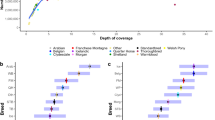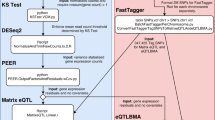Abstract
Recurrent laryngeal neuropathy (RLN) is a major upper-airway disease of horses that causes abnormal respiratory noise during exercise and can impair performance. Etiopathogenesis remains unclear but genetic factors have been suspected for many decades. The objective of this study was to identify risk loci associated with RLN. To that end we genotyped 234 cases (196 Warmbloods, 20 Trotters, 14 Thoroughbreds, and 4 Draft horses), 228 breed-matched controls, and 69 parents with the Illumina Equine SNP50 BeadChip. Using these data, we quantified population structure and performed single-marker and haplotype-based association studies, as well as family-based linkage analyses. We accounted for population stratification by modeling a random polygenic background effect with covariance structure estimated from genome-wide SNP data. Using the haplotype-based approach, we identified two genome-wide suggestive loci in Warmbloods, respectively on chromosomes 21 (p = 1.62 × 10−6) and 31 (p = 1.69 × 10−5). The two signals were driven by the enrichment of a “protective” haplotype in controls compared to cases.


Similar content being viewed by others
References
Altshuler D, Daly MJ, Lander ES (2008) Genetic mapping in human disease. Science 322:881–888
Anderson BH, Kannegieter NJ, Goulden BE (1997) Endoscopic observations on laryngeal symmetry and movements in young racing horses. N Z Vet J 45:188–192
Archer RM, Lindsay WA, Duncan ID (1989) Equine laryngeal hemiplegia-endoscopic survey of 400 draft horses. Vet Surg 18:62–63
Aulchenko YS, Ripke S, Isaacs A, van Duijn CM (2007) GenABEL: an R library for genome-wide association analysis. Bioinformatics 23:1294–1296
Balding DJ (2006) A tutorial on statistical methods for population association studies. Nat Rev Genet 7:781–791
Barakzai S (2009) Heritability of recurrent laryngeal neuropathy. In: 4th World equine airways symposium, Berne, Switzerland, 5-7 August 2009, pp 40-42. www.ivis.org
Barisic N, Claeys KG, Sirotkovic-Skerlev M, Lofgren A, Nelis E, De Jonghe P, Timmerman V (2008) Charcot-Marie-Tooth disease: a clinico-genetic confrontation. Ann Hum Genet 72:416–441
Beard WL, Haynes HM (1993) Risk factors for laryngeal hemiplegia in the horse. Prev Vet Med 17:57–63
Brakenhoff JE, Holcombe SJ, Hauptman JG, Smith HK, Nickels FA, Caron JP (2006) The prevalence of laryngeal disease in a large population of competition draft horses. Vet Surg 35:579–583
Brown JA, Jackson MA, Dredge AF, O’Callaghan PA, McCaffrey JP, Slocombe RF, Clarke AF (2005) Prevalence of pharyngeal and laryngeal abnormalities in Thouroughbreds racing in Australia, and their association with performance. Equine Vet J 37:397–401
Cahill JI, Goulden BE (1986a) Equine laryngeal hemiplegia. Part I. A light microscopic study of periperal nerves. N Z Vet J 34:161–169
Cahill JI, Goulden BE (1986b) Equine laryngeal hemiplegia. Part II. An electron microscopic study of peripheral nerve. N Z Vet J 34:170–175
Cahill JI, Goulden BE (1986c) Equine laryngeal hemiplegia. Part III. A teased fiber study of peripheral nerves. N Z Vet J 34:181–185
Cahill JI, Goulden BE (1987) The pathogenesis of equine laryngeal hemiplegia—a review. N Z Vet J 35:82–90
Chanock SJ, Manolio T, Boehnke M, Boerwinkle E, Hunter DJ, Thomas G, Hirschhorn JN, Abecasis G, Altshuler D, Bailey-Wilson JE, Brooks LD, Cardon LR, Daly M, Donnelly P, Fraumeni JF Jr, Freimer NB, Gerhard DS, Gunter C, Guttmacher AE, Guyer MS, Harris EL, Hoh J, Hoover R, Kong CA, Merikangas KR, Morton CC, Palmer LJ, Phimister EG, Rice JP, Roberts J, Rotimi C, Tucker MA, Vogan KJ, Wacholder S, Wijsman EM, Winn DM, Collins FS (2007) Replicating genotype-phenotype associations. Nature 447:655–660
Collins N, Milne E, Hahn C, Dixon P (2009) Correlation of the Havemeyer endoscopic laryngeal grading system with histopathological changes in equine Cricoarytenoideus dorsalis muscles. Irish Vet J 62:334–338
Devlin B, Roeder K (1999) Genomic control for association studies. Biometrics 55:997–1004
Devlin B, Roeder K, Wasserman L (2001) Genomic control, a new approach to genetic-based association studies. Theor Popul Biol 60:155–166
Dixon PM, McGorum BC, Railton DI, Hawe C, Tremaine WH, Pickles K, McCann J (2001) Laryngeal paralysis: a study of 375 cases in a mixed-breed population of horses. Equine Vet J 33:452–458
Dixon PM, McGorum BC, Railton DI, Hawe C, Tremaine WH, Pickles K, McCann J (2002) Clinical and endoscopic evidence of progression in 152 cases of equine recurrent laryngeal neuropathy (RLN). Equine Vet J 34:29–34
Dixon PM, Hahn CN, Barakzai SZ (2009) Recurrent laryngeal neuropathy (RLN) research: where are we and to where are we heading? Equine Vet J 41:324–327
Druet T, Georges M (2010) A hidden Markov model combining linkage and linkage disequilibrium information for haplotype reconstruction and quantitative trait locus fine mapping. Genetics 184:789–798
Ducharme NG, Hackett RP, Fubini SL, Erb HN (1991) The reliability of endoscopic examination in assessment of arytenoid cartilage movement in horses. Part II. Influence of side of examination, reexamination, and sedation. Vet Surg 20:180–184
Duerr RH, Taylor KD, Brant SR, Rioux JD, Silverberg MS, Daly MJ, Steinhart AH, Abraham C, Regueiro M, Griffiths A, Dassopoulos T, Bitton A, Yang H, Targan S, Datta LW, Kistner EO, Schumm LP, Lee AT, Gregersen PK, Barmada MM, Rotter JI, Nicolae DL, Cho JH (2006) A genome-wide association study identifies IL23R as an inflammatory bowel disease gene. Science 314:1461–1463
Duncan ID, Griffiths IR, Madrid RE (1978) Light and electron-microscopic study of the neuropathy of equine idiopathic laryngeal hemiplegia. Neuropathol Appl Neurobiol 4:483–501
Garrett KS, Pierce SW, Embertson RM, Stromberg AJ (2010) Endoscopic evaluation of arytenoid function and epiglottic structure in Thoroughbred yearlings and association with racing performance at two to four years of age: 2,954 cases (1998–2001). J Am Vet Med Assoc 236:669–673
Georges M (2007) Mapping, fine mapping, and molecular dissection of quantitative trait loci in domestic animals. Annu Rev Genomics Hum Genet 8:131–162
Goddard ME, Hayes BJ (2009) Mapping genes for complex traits in domestic animals and their use in breeding programmes. Nat Rev Genet 10:381–391
Goulden BE, Anderson LJ (1981a) Equine laryngeal hemiplegia. 1. Physical characteristics of affected animals. N Z Vet J 29:151–154
Goulden BE, Anderson LJ (1981b) Equine laryngeal hemiplegia. 2. Some clinical observations. N Z Vet J 29:194–198
Hahn CN, Matiasek K, Dixon PM, Molony V, Rodenacker K, Mayhew IG (2008) Histological and ultrastructural evidence that recurrent laryngeal neuropathy is a bilateral mononeuropathy limited to recurrent laryngeal nerves. Equine Vet J 40:666–672
Ibi T, Miyake T, Hobo S, Oki H, Ishida N, Sasaki Y (2003) Estimation of heritability of laryngeal hemiplegia in the Thoroughbred horse by Gibbs sampling. J Equine Sci 14:81–86
Irobi J, De Jonghe P, Timmerman V (2004) Molecular genetics of distal hereditary motor neuropathies. Hum Mol Genet 13(Spec No 2):R195–R202
Lander E, Kruglyak L (1995) Genetic dissection of complex traits: guidelines for interpreting and reporting linkage results. Nat Genet 11:241–247
Lane JG, Ellis DR, Greet TRC (1987) Observations on the examination of Thoroughbred yearlings for idiopathic laryngeal hemiplegia. Equine Vet J 19:531–536
Marti E, Ohnesorge B (2002) Genetic basis of respiratory disorders. In: Lekeux P (ed) Equine respiratory diseases. International Veterinary Information Service, Ithaca. www.ivis.org
Meuwissen TH, Hayes BJ, Goddard ME (2001) Prediction of total genetic value using genome-wide dense marker maps. Genetics 157:1819–1829
Momozawa Y, Mni M, Nakamura K, Coppieters W, Almer S, Amininejad L, Cleynen I, Colombel JF, de Rijk P, Dewit O, Finkel Y, Gassull MA, Goossens D, Laukens D, Lemann M, Libioulle C, O’Morain C, Reenaers C, Rutgeerts P, Tysk C, Zelenika D, Lathrop M, Del-Favero J, Hugot JP, de Vos M, Franchimont D, Vermeire S, Louis E, Georges M (2011) Resequencing of positional candidates identifies low frequency IL23R coding variants protecting against inflammatory bowel disease. Nat Genet 43:43–47
Ohnesorge B, Deegen E, Miesner K, Geldermann H (1993) Hemiplegia laryngis in horses - an examination of stallions, mares and their offspring. J Vet Med Ser A 40:134–154
Perkins JD, Salz RO, Schumacher J, Livesey L, Piercy RJ, Barakzai SZ (2009) Variability of resting endoscopic grading for assessment of recurrent laryngeal neuropathy in horses. Equine Vet J 41:342–346
Piercy RJ, Gath C, Powell E, Massey C, Stanley R, Barakzai S, Perkins JD (2009) Examining the association between resting endoscopic grade of recurrent laryngeal neuropathy and both objective and subjective histopathologic assessment of the laryngeal intrinsic musculature. In: Tessier C, Gerber V (eds), Fourth world equine airways symposium, Berne, Switzerland), 5-7 August 2009, p 233
Poncet PA, Montavon S, Gaillard C, Barrelet F, Straub R, Gerber H (1989) A preliminary report on the possible genetic basis of laryngeal hemiplegia. Equine Vet J 21:137–138
Purcell S, Neale B, Todd-Brown K, Thomas L, Ferreira MA, Bender D, Maller J, Sklar P, de Bakker PI, Daly MJ, Sham PC (2007) PLINK: a tool set for whole-genome association and population-based linkage analyses. Am J Hum Genet 81:559–575
Robinson NE (2004) Consensus statements on equine recurrent laryngeal neuropathy: conclusions of the Havemeyer Workshop. Equine Vet Educ 16:333–336
Sweeney CR, Maxson AD, Soma LR (1991) Endoscopic findings in the upper respiratory tract of 678 Thoroughbred racehorses. J Am Vet Med Assoc 198:1037–1038
Visscher PM (2008) Sizing up human height variation. Nat Genet 40:489–490
Warner LE, Mancias P, Butler IJ, McDonald CM, Keppen L, Koob KG, Lupski JR (1998) Mutations in the early growth response 2 (EGR2) gene are associated with hereditary myelinopathies. Nat Genet 18:382–384
Weir BS (2008) Linkage disequilibrium and association mapping. Annu Rev Genomics Hum Genet 9:129–142
Acknowledgments
We are grateful to veterinarians for phenotypic data and sample collection (Drs. Aebisher, Antys, Bayssat, Berthelot, Betsch, Boening, Bussy, Ciantar, Colin, Corde, Delarue, Foursin, Geffroy, Goupil, Lefere, Palmers, Pechayre, Picandet, Plainfossé, Scicluna, Simon, Stockwell, Tessier, Van Erck); to Julien de Curraize for his help with horses and data management; to Naima Ahariz, Nadine Cambisano, Sarah Géron, and the GIGA genotranscriptomic core facility for their assistance with genotyping; to Wanbo Li and Cecile Lam for their assistance with sequencing; and to INRA-SAGA, INRA-GABI, and LABOGENA for their collaboration on the GENEQUIN research program. This work was funded by grants from the Agence Nationale de la Recherche (ANR), the Fond Eperon, the Haras Nationaux—Institut Français du Cheval et de l’Equitation (IFCE) and the Région Basse-Normandie (France). Tom Druet is Research Associate from the Fonds de la Recherche Scientifique—FNRS.
Author information
Authors and Affiliations
Corresponding author
Electronic supplementary material
Below is the link to the electronic supplementary material.
Rights and permissions
About this article
Cite this article
Dupuis, MC., Zhang, Z., Druet, T. et al. Results of a haplotype-based GWAS for recurrent laryngeal neuropathy in the horse. Mamm Genome 22, 613–620 (2011). https://doi.org/10.1007/s00335-011-9337-3
Received:
Accepted:
Published:
Issue Date:
DOI: https://doi.org/10.1007/s00335-011-9337-3




